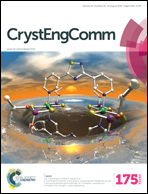Design and synthesis of luminescent porous coordination polymers for chromaticity modulation, sensing of nitrobenzene and iodine encapsulation†
Abstract
We design and prepare a family of luminescent porous coordination polymers (PCPs) constructed from three C2v symmetry ligands with increased conjugation moieties. Single crystal X-ray analyses revealed that their pore types/sizes and volumes were systematically tuned. Eu-based NTU-5 and NTU-8 emit red light. However, in contrast to the typical green emission of Tb-based PCPs, the increased conjugation moieties in NTU-6 and NTU-9 with a Tb center resulted in a very unusual blue emission. These unique emissions from these iso-structures demonstrated varied pathways of electronic transfer, which were further confirmed by lifetime experiments. Encouraged by these observations, the chromaticity modulation from pink to blue has been well realized by a facile method of self-assembly of the Te-H3L ligand and varied molar ratios of Eu3+/Tb3+ ions. Additionally, NTU-6 and NTU-9 showed high potential for nitrobenzene sensing (quenching effect coefficients: 589.5 and 445.6 M−1) and encapsulation of I2 molecules.


 Please wait while we load your content...
Please wait while we load your content...